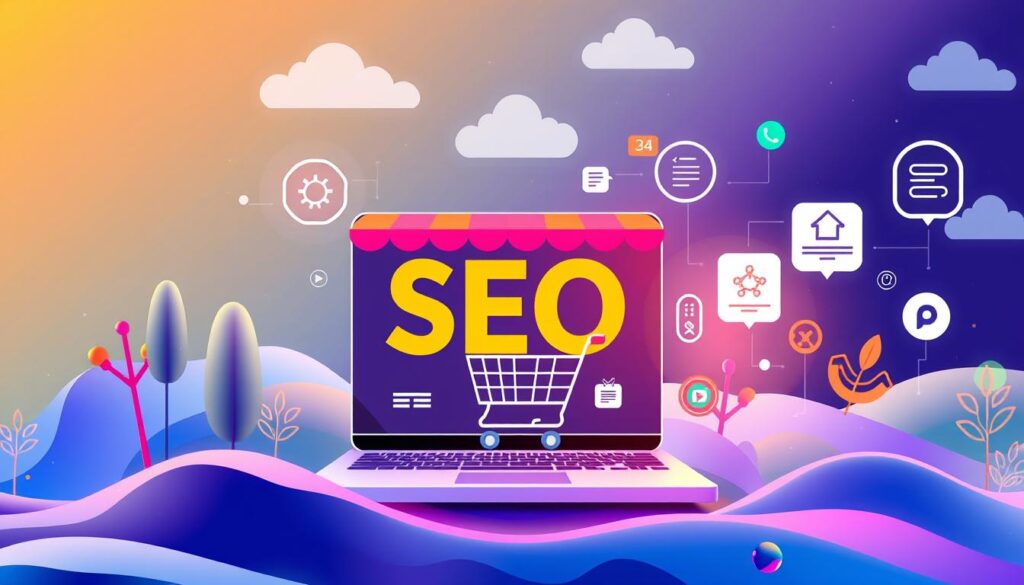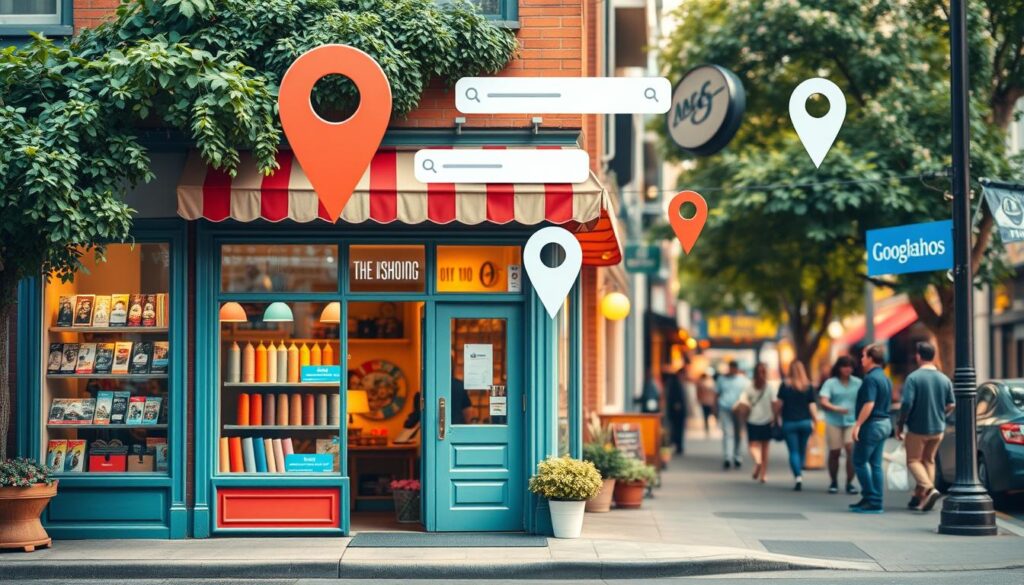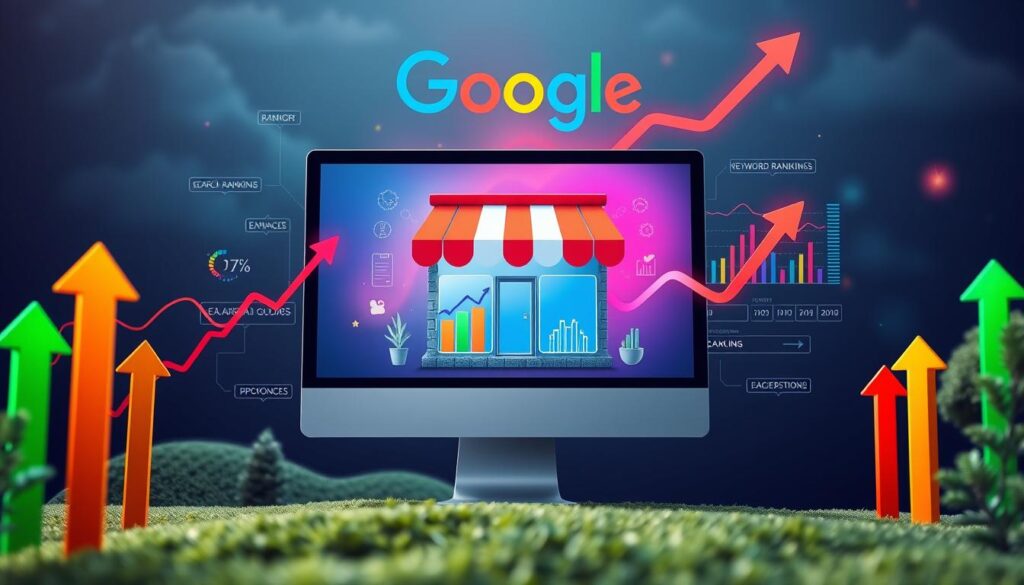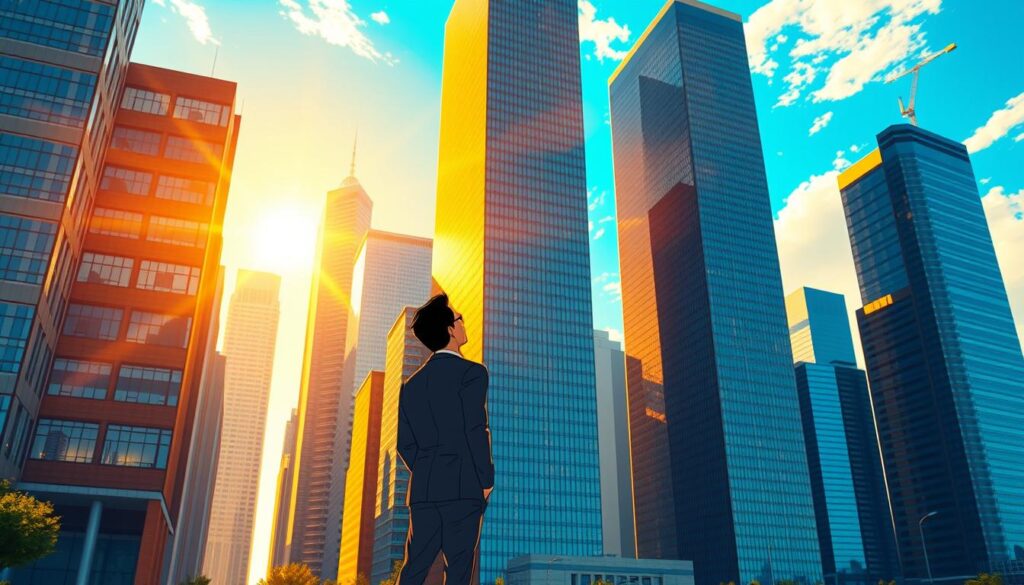Ever wondered why your online shop can’t draw in customers, even with great products? The secret might be in Search Engine Optimization (SEO). Learning how to do SEO for your shop could be the key to getting more visibility online and converting browsers into buyers.
SEO is crucial for shop owners wanting to boost their online presence. When search engines understand your content, you get more visibility on search pages. This means more customers find you when they’re looking for what you offer. Experts like Revenue Boomers say good SEO can really increase your online sales.
This guide is here to give you simple SEO tips and steps to follow. We’ll cover everything from finding the right keywords to building your shop’s authority online. By the end, you’ll know how to make your shop more visible.
Key Takeaways
- SEO helps search engines understand content and connect users with relevant sites.
- Following Search Essentials can enhance your chances of ranking higher on Google.
- Changes in SEO can yield both quick and long-term results.
- Using descriptive URLs aids both users and search engines.
- Unique, well-structured content significantly influences search result rankings.
- Most search engine users rarely venture beyond the first page of results.
- Investing time in learning SEO sets your shop apart from competitors.
Understanding SEO and Its Importance for Your Shop
SEO, or search engine optimization, is key for any shop wanting to shine online. It helps search engines understand your website’s content. This can make your shop more visible, bring in more visitors, and attract new customers.
Knowing why SEO matters for shops means it’s not just about being top in search results. It’s also about building trust and being seen as an authority. With billions of Google searches every day, good SEO helps your shop reach the right people. It’s all about using technical, on-site, and off-site SEO to grow your shop over time.
Creating great content like blogs, videos, and infographics, and using the right keywords, can help you rank better. This approach not only widens your customer base but also boosts the chance of turning visitors into loyal customers. Backlinks show your shop’s credibility, which search engines value a lot.
With more people using mobiles, having a site that works well on phones is now a must for SEO. In fact, most website visits come from organic searches. Using AI in your SEO can also help your shop stand out. Keeping up with Google’s E-A-T guidelines will also strengthen your SEO efforts.
How to Do SEO for My Shop?
Starting with SEO for shops means knowing your target market and their search terms. It’s key to focus on strategies that work well for stores in today’s digital world. First, find the right keywords that match what your customers are looking for. Use these keywords in your product titles and descriptions to get noticed by search engines.
Using Google Merchant Center is a big step to show your products on Google platforms. It helps manage your product listings better, boosting your online presence. Also, make sure your product titles start with keywords to get more clicks. An optimized title helps with ranking and catches the eye of potential buyers.
Make sure your product descriptions talk about what makes your items special. Good descriptions can turn visitors into buyers, which is important for SEO. Use product images well; having more than one image can make your shop more appealing. Google lets you add up to ten images per product, so you can show off your products in different ways.
Adding structured data can also improve your shop’s SEO. Using Google Product Categories and Product Types helps search engines understand your products better. For local customers, using local SEO strategies can really help. Getting involved in your local community and optimizing your Google My Business listing can bring in more customers both online and in person.
| SEO Component | Best Practices | Impact |
|---|---|---|
| Keyword Research | Identify and use relevant keywords. | Enhances visibility in search results. |
| Product Titles | Include keywords at the beginning. | Increases click-through rates. |
| Product Descriptions | Highlight unique benefits. | Improves conversion rates. |
| Images | Use multiple high-quality images. | Enhances user experience. |
| Local SEO | Optimize Google My Business. | Drives local traffic. |
By following these steps, shop owners can improve their SEO to grow their business. It’s all about finding the right strategies for your shop in a competitive market.
Keyword Research for Your Shop’s SEO Strategy
Keyword research is key to SEO strategy, crucial for online shops to get noticed. Choosing the right keywords brings in traffic, drawing in customers looking for your products. Using keyword research tools helps shop owners pick terms that match their audience and products.
The Role of Keywords in SEO
Finding the right keywords is vital for Google rankings. Long-tail keywords have less competition but are more specific, perfect for niche items. Using keywords in titles, tags, and descriptions boosts visibility. Knowing what shoppers want, like from Etsy’s search bar, helps shops stand out in crowded markets.
Tools for Effective Keyword Research
Effective keyword research tools make finding the best keywords easier. Google Keyword Planner, Ahrefs, and SEMrush analyze keyword difficulty and search volume. Etsy sellers benefit from EtsyHunt, which offers keyword lists and competition data. Pinterest also provides real-time keyword ideas through auto-complete and related searches.
Studying competitors reveals valuable keywords. It’s crucial to use both AI and traditional methods to match buyer behavior. For a detailed guide on starting keyword research, check out this resource.
| Tool | Main Features | Benefits |
|---|---|---|
| Google Keyword Planner | Keyword suggestions, search volume data | Free to use, direct from Google |
| Ahrefs | Keyword difficulty, ranking analysis | Comprehensive site audit capabilities |
| SEMrush | Keyword tracking, content optimization | Diverse features for competitors’ analysis |
| EtsyHunt | Keyword recommendations, view estimates | Focused on Etsy market dynamics |
| Search suggestions, related keyword ideas | Visually driven content discovery |
On-Page SEO Best Practices for Shops
On-page SEO is key to making your shop visible and ranked on search engines. By using smart strategies, you can boost your site’s performance. This section covers essential shop SEO best practices to help optimize your shop.
Using Descriptive URLs
Descriptive URLs are great for both users and SEO. They make it clear what the page is about and help search engines understand it better. A good URL should have relevant keywords. For example, www.shop.com/custom-handmade-tote is better than www.shop.com/product123 for SEO.
Optimizing Title Tags and Meta Descriptions
Title tags and meta descriptions are crucial for getting more clicks. Make sure your title tags have main keywords and are 55 to 60 characters long. Meta descriptions should be 150 to 155 characters and should make people want to click. Keep these up to date to attract more organic traffic.
Content Quality and User Experience
Quality content keeps visitors and lowers bounce rates. Write engaging product descriptions with the right keywords. Using related terms also boosts content quality. Plus, make sure your site is easy to navigate to improve user experience and sales.

| Best Practice | Description |
|---|---|
| Descriptive URLs | Enhances clarity and context for users and search engines. |
| Title Tags | Includes primary keywords; optimal length of 55-60 characters. |
| Meta Descriptions | Encourages clicks; ideal length of 150-155 characters. |
| Content Quality | Engaging and informative; includes relevant terms and keywords. |
| User Experience | Intuitive navigation; reduces bounce rates and enhances customer retention. |
Creating Compelling Content for SEO
Creating engaging content is key to successful shop SEO. It attracts and keeps visitors. Content that stands out can earn links and shares, boosting visibility.
Strategies for Blog Posts and Articles
Blog posts and articles are great for engaging content. They encourage more interaction than product pages. Here are some tips:
- Make an editorial calendar for regular content. It helps avoid last-minute rushes.
- Use keyword research to pick popular topics. This meets search needs.
- Add infographics for their data appeal. They draw page views.
- Share your content on social networks. It boosts reach and visibility.
Importance of Unique and Useful Content
Creating unique, useful content is crucial. Thin content can harm your shop’s online presence. Here’s how to make effective content:
- Focus on quality over quantity. Your content should be accurate, original, and valuable.
- Avoid keyword stuffing. Natural use of keywords is better.
- Make content for specific markets. High-level white papers for B2B can stand out.
- Keep up with user intent. This helps meet different search needs.
| Content Type | Engagement Potential | Link Attraction |
|---|---|---|
| Blog Posts | High | Yes |
| Articles | Moderate | Yes |
| Videos | High | Potentially |
| Infographics | Very High | Yes |
Technical SEO for Your Shop
Technical SEO for shops is key to good search engine optimization. It needs a deep understanding of web development and how search engines work. By following best practices, your site will be indexed well and rank high in search results.
Ensuring Google Can Access Your Content
Good internal linking helps spread link equity across your site. This makes your pages easier for search engines to find and index. Google Search Console can show you any issues with your site’s visibility.
Having a proper robots.txt file helps search engines move through your site easily. Fixing broken links, 404 errors, and redirects also boosts your site’s performance.
Mobile Optimization and Page Speed
Having a mobile-friendly website improves user experience. Fast websites rank better and keep users engaged. In fact, sites that load quickly can see a big increase in conversions.
Improving your site’s speed is crucial for SEO. It affects both user experience and how search engines see your site. Regular checks can help fix any speed issues.
Site Structure and Navigation
A well-organized site is essential for technical SEO. A simple structure makes it easy for users to find what they need. Good navigation, like mega menus, helps users find products quickly.
Fixing duplicate content issues with canonical tags also helps your site’s performance. This ensures all your content is seen as unique by search engines.
Building Authority with Off-Page SEO
Building your shop’s online authority needs good off-page SEO strategies. This method involves actions outside your site that boost your search rankings and brand image. Getting quality backlinks is key, showing search engines your content is reliable.
The Importance of Backlinks
Backlinks are like endorsements for your site. Semrush says a site’s authority is measured by its backlink quality and quantity. Getting high-quality backlinks can really help your shop’s ranking.
There are ways to get more backlinks, like broken link building. This means asking site owners to replace old links with new ones to your content. Guest blogging on sites with high authority can also help.
Leveraging Social Media to Boost Visibility
Social media is key for off-page SEO, helping your brand get seen more and driving traffic. By engaging with your audience, you can get more shares and mentions. This can lead to more people finding your shop online.
Sharing interesting content can make people talk about your shop. Working with influencers can also boost your brand and get you valuable backlinks and social signals.
Local SEO Tips for Shops
Local SEO is key for shops to get more foot traffic and local customers. Good local SEO strategies make your business more visible in local searches. This can lead to more sales. Here are some tips to boost your local online presence:
- Create a Google Business Profile: This is the base of local SEO. Make sure your profile is up-to-date and accurate to get seen more.
- Optimize for Local Keywords: Use long-tail keywords that include your location. This helps you show up in searches like “Italian restaurants near me.”
- Gather Customer Reviews: Online reviews are important for rankings. Ask happy customers to leave feedback to make your shop look better.
- Utilize Social Media Platforms: Use social media to connect with your local community. This can bring more people to your website and make your brand more known.
- Consistent Citations: Make sure your business info (NAP) is the same everywhere online. Google sees this as trustworthy.
- Enhance Visibility in Google Maps: Know how Google ranks local businesses. Focus on being relevant, close, and well-known to rank higher.
Voice searches are getting more common, making up nearly half of all searches. Optimizing for voice can really help your local SEO. Use tools like Google Keyword Planner to find good keywords. Also, check your Google My Business (GMB) insights to see how you’re doing in local searches. By using these tips, your shop can stand out and get more customers.

Tracking and Analyzing Your SEO Efforts
Measuring your SEO success is key to doing well online. Shop owners can use analytics tools to learn a lot. This part talks about the best tools and metrics to watch, helping you improve your online shop.
Understanding Analytics Tools
Google Analytics and Google Search Console are must-haves. They help you see how your site is doing. By using them, you can check things like how many people visit, how long they stay, and if they buy anything. Keeping an eye on these tools helps you spot what’s working and what’s not.
Key Performance Indicators for SEO Success
Choosing the right KPIs for SEO is important. Here are some key ones:
| Metric | Description | Tool for Measurement |
|---|---|---|
| Organic Traffic | Visits from unpaid search engine results | Google Analytics |
| Keyword Rankings | Position on search engine results for specific keywords | Position Tracking Tool |
| SERP Visibility | Presence in search engine results pages for relevant keywords | Position Tracking Tool |
| Impressions | Number of times a website appeared in search results | Google Search Console |
| Click-Through Rate (CTR) | Percentage of users who click on the website in SERPs | Google Search Console |
| Conversions | Completion of desired actions on the site | Google Analytics |
| Bounce Rate | Percentage of users leaving without engaging | Google Analytics |
| Website Authority | Predicts ranking success on search engines | Semrush |
By focusing on these key metrics, you can really see how your SEO is doing. Knowing these things helps you make smart choices. This way, you can keep getting better at tracking your shop’s online success.
Boosting Shop Rankings on Google
To improve your shop’s Google ranking, you need a mix of SEO techniques. Start by making your titles, headers, and content better for keywords. Using LSI keywords adds depth to your content, making it more relevant to what users are searching for.

Schema markup is key to presenting your content well. It helps search engines understand your content better. This can lead to rich snippets that draw in users. Also, keep your content fresh by updating it regularly. This keeps your information relevant and helps maintain your ranking.
Here are some strategies to boost your rankings:
- Use SEO-friendly plugins to make your WordPress site better.
- Create long-form content, as articles around 1,447 words tend to rank better on Google’s first page.
- Focus on site speed and mobile optimization. Over half of website traffic comes from mobile devices.
- Engage with your audience by responding to reviews. This improves visibility and can boost your ranking.
Local SEO is important for businesses. Having accurate Google My Business listings and positive reviews helps you show up in local searches. Google looks at relevance, distance, and how prominent you are when ranking locally. So, managing your online reputation and getting positive reviews are key to improving your shop’s Google ranking.
| Strategy | Description | Impact on Rankings |
|---|---|---|
| Content Optimization | Use relevant keywords and LSI to enhance on-page SEO. | Higher visibility in search results. |
| Schema Markup | Helps search engines understand content better. | Potential for featured snippets. |
| Site Speed & Mobile Optimization | Ensure fast loading times and mobile-friendly design. | Positive effect on user experience and rankings. |
| Engaging with Reviews | Respond to customer reviews promptly. | Increases visibility and enhances reputation. |
| Regular Content Updates | Keep existing content fresh and relevant. | Helps maintain rankings over time. |
By using these strategies, you can improve your shop’s ranking on Google. This will help you attract more customers online.
Common Mistakes to Avoid in Shop SEO
SEO is key to getting more people to see your shop online. Many shop owners make mistakes that hurt their SEO. Knowing these mistakes can help you do better online.
Neglecting Keyword Research
Not doing keyword research is a big mistake. Keywords connect what people search for with your content. Without the right keywords, you miss out on visitors. It’s important to know what your customers are looking for.
Use tools like Google Keyword Planner or Ahrefs to find good keywords for your products.
Not Measuring Results Effectively
Many shop owners don’t check how well their SEO is working. Checking your SEO results regularly helps you improve. Use analytics tools to watch things like how many people visit your site and how many buy something.
Knowing what works and what doesn’t helps you make better choices. This way, you can make your shop’s SEO better.
| SEO Mistakes | Implications | Solutions |
|---|---|---|
| Poor Keyword Research | Low visibility and missed traffic | Conduct comprehensive keyword studies |
| Ignoring Analytics | Uninformed decisions | Implement regular tracking of performance |
| Overusing Keywords | Potential penalties from search engines | Focus on natural keyword integration |
| Neglecting User Experience | High bounce rates | Improve site design and navigation |
Staying Updated with SEO Trends and Changes
In the fast-changing world of search engine optimization, staying informed about SEO trends is key. Knowing the latest updates helps your shop shine online. By keeping up with these changes, shop owners can adjust their strategies and stay visible in search results.
Resources for Ongoing Learning
There are many SEO resources today to boost your knowledge. Here are some great options:
- Industry Blogs: Reading blogs like Moz, Search Engine Journal, and Neil Patel gives you the latest on trends and best practices.
- Online Courses: Sites like Coursera and Udemy offer courses on SEO basics and advanced tactics. You can learn at your own speed.
- Forums and Online Communities: Joining forums like Reddit and Warrior Forum lets you talk about trends, share tips, and learn from others.
- Webinars and Podcasts: Going to SEO webinars or listening to podcasts keeps you updated on new strategies and trends.
As search engines like Google keep changing and improving, using these SEO resources is vital. By always learning, you can adapt to new changes and use SEO strategies that meet user needs.
| Resource Type | Purpose | Examples |
|---|---|---|
| Industry Blogs | Insights on trends and best practices | Moz, Search Engine Journal |
| Online Courses | Learner’s guide to SEO | Coursera, Udemy |
| Forums | Community discussions and tips | Reddit, Warrior Forum |
| Webinars | Live updates on strategies and changes | Industry seminars and presentations |
Conclusion
SEO strategies for shops are key to boosting visibility and driving traffic. Shop owners must focus on both on-page and off-page SEO. This creates a strong online presence that draws in customers.
By using these strategies, businesses see better click-through rates and lower marketing costs. They also get improved user experiences, leading to more sales.
Improving shop visibility means keeping your Google Business Profile up to date. It’s also important to have consistent NAP (Name, Address, Phone Number) across directories. Local SEO is crucial, as many customers use search engines to find what they need.
Using resources like comprehensive guides on local SEO can help refine your approach. This boosts your online visibility.
Continuous learning and effective SEO tactics are vital in today’s e-commerce world. As global retail ecommerce sales grow, shop owners must adapt. They may need specialized support to reach their full SEO potential.






